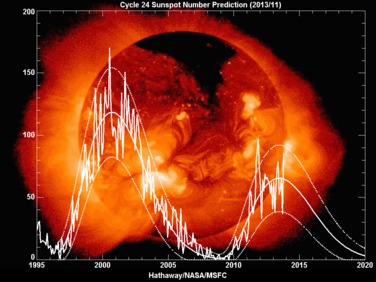The solar maximum in 1989 triggered a power surge that damaged transformers in the Hydro Quebec power grid and left six million people in Canada and the northeast United States without power for more than nine hours. The event also knocked satellites out of orbit and disrupted radio communications.
Now, as our world relies increasingly on satellites for daily communication, the risks become even higher. Cellular telephones, pagers, and the Global Position System—used for airline navigation, among other things—could be particularly vulnerable.
Daily observations of sunspots began in 1749 at the Zurich Observatory. Other observatories began contributing later, and continuous observations began in 1849. The current eleven-year cycle, the twenty-fourth to have been measured by modern scientists, is called Solar Cycle Number 24.
As we learn more about the sun, scientists are beginning to suspect that solar cycles affect more than just satellites and power grids. An active sun, for instance, can add more heat to the Earth's outer atmosphere and alter our climate. A small ice age from 1645 to 1715 corresponded to a time of reduced solar activity, and current temperature increases could be related to increased solar activity.
For northern residents, more solar radiation means an increase in the Aurora Borealis, or Northern Lights. The solar wind sends charged particles crashing into Earth's atmosphere every day. These particles are attracted to the poles by Earths magnetosphere, where they excite molecules of nitrogen and oxygen and create colorful displays of light. The displays are more pronounced during the peak of the sunspot cycle.
